Related Research Articles

The Gloster Gladiator is a British biplane fighter. It was used by the Royal Air Force (RAF) and the Fleet Air Arm (FAA) and was exported to a number of other air forces during the late 1930s.

The Hawker Fury is a British biplane fighter aircraft used by the Royal Air Force in the 1930s. It was a fast, agile aircraft, and the first interceptor in RAF service capable of speed higher than 200 mph in level flight. It was the fighter counterpart to the Hawker Hart light bomber.

The Hawker Nimrod is a British carrier-based single-engine, single-seat biplane fighter aircraft built in the early 1930s by Hawker Aircraft.

The Gloster Grebe was developed by the Gloster Aircraft Company from the Gloster Grouse, and was the Royal Air Force's first post-First World War fighter aircraft, entering service in 1923.

The Hawker Woodcock was a British single-seat fighter built by the Hawker Engineering Company as the first fighter to be produced by Hawker Engineering. It was used by the RAF as a night fighter in the 1920s.
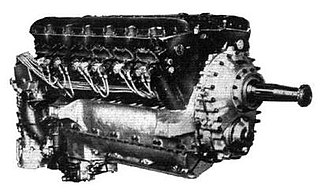
The Rolls-Royce Goshawk was a development of the Rolls-Royce Kestrel that used evaporative or steam cooling. In line with Rolls-Royce convention of naming piston engines after birds of prey, it was named after the goshawk.

The Gloster Gauntlet was a single-seat biplane fighter designed and produced by the British aeroplane manufacturer Gloster Aircraft in the 1930s. It was the last fighter to be operated by the Royal Air Force (RAF) to have an open cockpit, and also the penultimate biplane fighter in its service.

The Gloster F.5/34 was a British fighter of the 1930s. It was a single-seat, single-engine monoplane of all-metal cantilever construction; the undercarriage was of the tailwheel type with retractable main wheels.

The Supermarine Type 224 was an inverted gull-wing monoplane fighter aircraft designed by R.J. Mitchell at Supermarine in response to Air Ministry Specification F.7/30, which sought a fighter for introduction to succeed the Gloster Gauntlet. It was powered by the Rolls-Royce Goshawk engine, which used an experimental evaporative cooling system, and problems with this system, combined with its disappointing performance, led to it being rejected, a contract for production aircraft eventually going to the Gloster Gladiator. It is nevertheless notable because R.J. Mitchell learnt lessons from its failure that were to contribute greatly to his success with the Supermarine Spitfire.

The Gloster SS.35 Gnatsnapper was a British naval biplane fighter design of the late 1920s. Two prototypes were built but the type did not enter production.
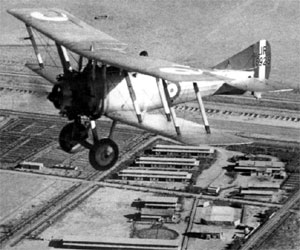
The Nieuport Nighthawk was a British fighter aircraft developed by the Nieuport & General Aircraft company for the Royal Air Force towards the end of the First World War. Although ordered into production before the aircraft first flew, it did not enter large scale service with the RAF owing to unreliable engines. Re-engined aircraft did see service in Greece, serving from 1923 to 1938.

The Westland Interceptor was a fighter developed by the British company Westland Aircraft to Air Ministry Specification F.20/27. When tested in 1929 and 1930, it showed unsatisfactory handling characteristics and was rejected by the RAF in favour of the Hawker Fury biplane fighter.
The Westland N.1B was a prototype British single-engined floatplane fighter aircraft of the First World War. The first aircraft to be designed by Westland Aircraft, it was a single-engined tractor biplane. Despite good performance, only two aircraft were built, the Royal Naval Air Service operating landplane fighters from ships instead.

The Bristol Type 123 was a single-seat, single-engine biplane fighter built to a United Kingdom Air Ministry specification for a four-gun fighter in the early 1930s. Only one was built.
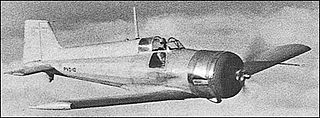
The Vickers Type 279 Venom was a British low-wing monoplane single-seat, single-engined, eight-gun fighter aircraft. It was fast and manoeuvrable but its Bristol Aquila radial engine was underpowered. Together with other designs built to the same specification, which included the Bristol Type 146, Gloster F.5/34, and Martin-Baker MB 2, it was rejected by the Air Ministry and only one Venom was built.
The Sopwith Snapper was a prototype British fighter aircraft of the First World War. A single-engined biplane designed by the Sopwith Aviation Company to replace the Sopwith Snipe fighter, it first flew after the end of the war, but did not enter service owing to the failure of its engine, only three aircraft being built.
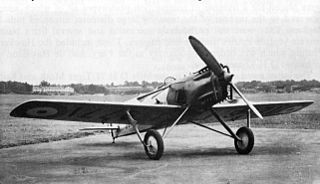
The de Havilland DH.77 was a prototype British fighter aircraft of the late 1920s. Intended as a fast climbing interceptor for Britain's Royal Air Force, the DH.77 was a lightweight low-wing monoplane powered by a relatively low power engine. Despite excellent performance, only one aircraft was built, the Hawker Fury biplane being preferred.

The Westland F.7/30 was a British fighter prototype. A single prototype was built in 1934, but the type was not put in production because its performance fell far below the RAF's requirements. The Gloster Gladiator won the F.7/30 competition.
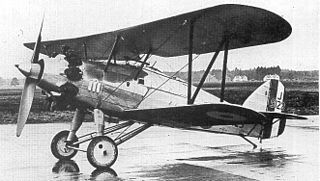
The Hawker F.20/27 was a British fighter design built to an Air Ministry specification for an interceptor in the late 1920s. It was a single-seat biplane powered by a radial engine; the very similar but V-12-engined Hawker Fury development proved superior and only one F.20/27 was built.
The Blackburn F3 was a British single-engined fighter aircraft produced in response to Air Ministry Specification F.7/30.
References
- Notes
- Bibliography
- Bowyer, Michael J.F. Interceptor Fighters for the Royal Air Force 1935–45. Wellingborough, UK: Patrick Stephens Limited, 1984. ISBN 0-85059-726-9.
- Goulding, James. Interceptor. London: Ian Allan, 1986. ISBN 0-7110-1583-X.
- Lewis, Peter. The British Fighter since 1912. London:Putnam. Fourth edition, 1979. ISBN 0-370-10049-2.
- Mason, Francis K. Hawker Aircraft since 1920. London: Putnam, Third edition, 1991. ISBN 0-85177-839-9.
- Mason, Francis K. The British Fighter since 1912. Annapolis, Maryland, USA: Naval Institute Press, 1992. ISBN 1-55750-082-7.